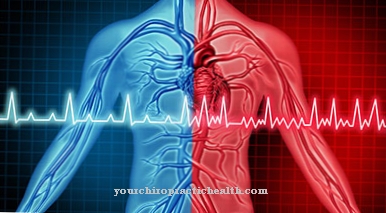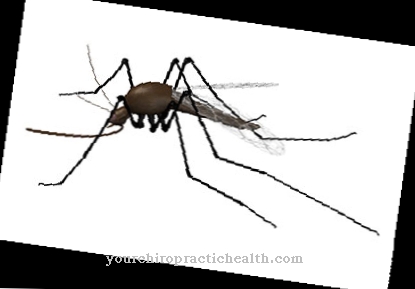From Yellow nail syndrome says the doctor with a triad of symptoms consisting of thickened, yellow discolored nails, pleural effusions and primary lymphedema. Sometimes, but not always, the yellow nail syndrome is the symptom of higher-level diseases such as malignant cancer. The causal treatment depends on the underlying disease, but always includes a puncture of the pleura on the symptomatic side.
What is yellow nail syndrome?
Like hair, nails are organs of attachment to the skin. These are keratin plates that show pathological changes in the course of various diseases. Yellow discolored nails can indicate faulty currencies. They can occur with tobacco consumption or be the symptom of certain syndromes.
They correspond to an independent clinical picture in the context of the so-called Yellow nail syndromes. This clinical picture was first described in 1964. Samman and White are considered to be the first to describe it. In addition to the term yellow nail syndrome, terms such as Scleronychia syndrome spread.
In addition to the discoloration of the nails, the syndrome is manifested by characteristic symptoms in the area of the lungs. With a prevalence of around one case in 500,000 to 1,000,000 people, it is a rather rare disease that affects women slightly more often than men. The mean age of onset is 60 years. In principle, patients fall ill between the ages of 41 and 80 years.
causes
In many cases, the yellow nail syndrome is an independent disease. In individual cases, however, the symptoms of the syndrome have also been observed in cancer patients or those affected by immunological, rheumatological and endocrinological diseases. Kidney diseases or tuberculosis can also be associated with yellow nail syndrome in individual cases.
The same goes for medication such as penicillamine. Apparently, the lymphedema distichiasis syndrome can also be associated with a yellow nail syndrome. This superordinate disease is based on a primary causal mutation in the FOXC2 gene. In the context of cancer, the yellow nail syndrome was mainly observed in malignancy patients.
For the majority of all cases, however, the etiology remains unclear. From a pathophysiological point of view, symptomatic pleural effusions are the result of impaired lymphatic drainage or protein losses. The typical yellowing and thickening of the nails is pathophysiologically mostly due to slowed nail growth.
Symptoms, ailments & signs
Patients with yellow nail syndrome suffer from disordered nail growth symptoms. In addition to the nails of the fingers, the toenails are also often affected. Because of a slowdown in growth, the nails gradually thicken.
Over time, the growth disorder also leads to the yellow discoloration of the nails, which gives the syndrome its name. Sometimes the nails come loose from the nail bed. In individual cases they are not yellow, but green. Characteristically, the nail symptoms in the context of yellow nail syndrome are not present as an isolated phenomenon, but merely correspond to one of three typical symptoms.
The characteristic triad of symptoms includes nail growth disorders, pleural effusions and primary lymphedema. In addition to the accumulation of fluid in the chest area, the bronchi can expand. Recurring sinus infections are also a common symptom.
The bronchial changes often lead to bronchitis or bronchiectasis. In individual cases these symptoms are associated with α-1-antitrypsin deficiency and other lymph vessel changes.
Diagnosis & course of disease
The doctor first suspects yellow nail syndrome after taking a detailed anamnesis based on the clinical picture. Imaging of the lymphatic system as well as bronchi and pleura can confirm the first suspicion just as much as the laboratory diagnostic determination of α-1-antitrypsin. The prognosis for patients with yellow nail syndrome depends on various factors.
The degree of bronchial involvement is just as decisive in terms of prognosis as the possible presence of a superordinate disease. If the syndrome can be traced back to a primary disease, its treatability is decisive for the prognosis. In the case of malignant tumors in particular, the time at which the diagnosis is made plays an important role in the treatability and curability of the disease.
Complications
In general, the yellow nail syndrome leads to various complaints on the nails. These complaints primarily lead to a significantly reduced aesthetic appearance in the person concerned and thus in many cases to inferiority complexes or to a reduced self-esteem. This in turn can lead to bullying or teasing and have a very negative effect on the person's quality of life.
It is not uncommon for patients to suffer from psychological complaints. Growth disorders can also occur on the nails and make everyday life difficult. In addition to the complaints of the nails, the yellow nail syndrome also leads to inflammation in the nose or bronchitis in many cases. Patients often have difficulty breathing and swollen lymph nodes. In the area of the chest, water can also accumulate, which can make breathing difficult.
The treatment of the yellow nail syndrome usually takes place through a surgical procedure. There are no further complications. The symptoms are significantly alleviated and limited. Furthermore, the patients are dependent on different therapies in order to avoid further complaints. With early treatment, the life expectancy of the patient is not negatively influenced by the yellow nail syndrome.
When should you go to the doctor?
If there are changes in the nails on the fingers or toes, the observations should be discussed with a doctor.If there is a disturbance in growth or discoloration, there is cause for concern. Medical examinations are necessary so that the cause can be clarified and a diagnosis can be made. Unusual thickening of the nails should be understood as a warning signal from the organism. They indicate internal disorders for which medical care is indicated.
If the nails come loose from the nail bed, a doctor should be consulted immediately. If no accident or force caused the symptoms and visual changes, an assessment by a doctor is recommended. Special care is also required in the case of disturbances in breathing, breathing noises and swelling of the lymph. These are complaints that need to be investigated further. If the number of health irregularities increases over the course of several days or weeks, a doctor should be consulted immediately.
Chest complaints, tightness or general malaise should also be presented to a doctor. If there is repeated inflammation of the sinuses, there is also a need for action.
Treatment & Therapy
If the yellow nail syndrome occurs in the larger context of an underlying disease, full attention should be paid to the causative disease. Ideally, a causal treatment of the primary disease takes place. Curing the cause will also reduce the symptoms of the syndrome. Many cases of yellow nail syndrome have an unclear cause.
A causal therapy is not possible in these cases. In this context, treatment is purely symptomatic. Local and systemic therapy with vitamin E is used as a symptomatic form of therapy. Minimally invasive treatment is always required for existing effusions of the pleura.
This also applies to major primary diseases. This minimally invasive symptomatic treatment usually corresponds to a pleural puncture. During this therapeutic puncture of the pleura, the area of the pleura is relieved in order to restore the patient's ability to ventilate. To do this, the doctor punctures the space in the pleura between the ribs and the lungs.
The extent of the effusion is estimated beforehand by ultrasound. The doctor marks the puncture site on the basis of this imaging. In order not to injure the liver and spleen, the puncture site should not be below the sixth or seventh intercostal space. The puncture cannula is placed on the upper edge of the rib perpendicular to the skin.
The patient aspires continuously while the doctor inserts the cannula. After the pleural fluid has been aspirated, the doctor removes the steel mandrain and moves the cannula. The pleural effusion is punctured using a connected three-way stopcock.
prevention
The yellow nail syndrome can only be prevented to the extent that the primary causal diseases can be prevented. Since in many cases the syndrome cannot be traced back to an obvious primary disease, there are hardly any promising preventive steps available.
Aftercare
Those affected with yellow nail syndrome usually have very few and only very limited direct follow-up measures available, so that those affected with this disease should ideally consult a doctor very early and initiate treatment. There can be no independent healing. Since this is a genetic disease, a complete cure is usually not possible.
If there is another wish to have children, a genetic examination and counseling may be advisable in order to find out whether a recurrence of the yellow nail syndrome is possible in the descendants. Most of those affected with yellow nail syndrome are dependent on surgical interventions, which can alleviate and limit the symptoms.
Those affected should definitely rest and take it easy after the procedure. Avoid stress or physical activity in order not to unnecessarily burden the body. Furthermore, the support and help of one's own family are very important with this disease. This can also prevent depression and other mental illnesses. In general, it cannot be predicted whether the life expectancy of those affected will be limited.
You can do that yourself
If the nails are abnormal, your own lifestyle should be checked. Discoloration of the nails on fingers or toes can indicate improper diet. It is important to check whether a balanced diet rich in vitamins is taking place. Otherwise, changes must be made immediately to avoid an increase in symptoms or further illnesses.
In addition, the absorption of pollutants is to be avoided and should be switched off as soon as possible. The consumption of nicotine actively as well as passively can lead to serious health consequences. For many of those affected, physical contact with cigarettes, cigars or other forms of smoking leads to physical irregularities. On the other hand, daily care of the hands and especially the nails is helpful. This includes cleansing, removing skin subunits and supplying the skin with important nutrients. This enables preventive measures to be taken and stabilization of nail growth achieved.
Since the disease often indicates an existing cancer, the person affected needs mental strengthening to cope with the health problems. The immune system must be supported so that the person affected can successfully complete the necessary treatment measures. Stressors are to be reduced overall and sleep hygiene is to be optimized. In many cases against various forms of overload, which must be changed and reduced immediately.

.jpg)










.jpg)



.jpg)










.jpg)
